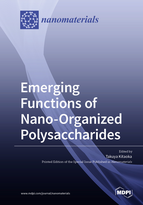Emerging Functions of Nano-Organized Polysaccharides
A special issue of Nanomaterials (ISSN 2079-4991). This special issue belongs to the section "Synthesis, Interfaces and Nanostructures".
Deadline for manuscript submissions: closed (31 December 2021) | Viewed by 33226
Special Issue Editor
Interests: cellulose; chitin; chitosan; polysaccharides; nanofibers; hybrid nanomaterials; interfacial catalysis; organocatalysis; green chemistry; biomaterials; biointerfaces; cell engineering; biomedical applications
Special Issue Information
Dear Colleagues,
Natural polysaccharides, such as cellulose, chitin, and starch, possess hierarchical nanoarchitectures, e.g., crystalline, nanofibrous, needle-like, helical, folded, and chain-aligned structures, in which macromolecular components assemble in a regular and organized manner during biosynthesis and physicochemical processing. Nanocellulose is one of the most promising nanomaterials in practical applications due to its high aspect ratio, high elastic modulus, high transparency, and low thermal expansion coefficient. Chitin nanofibers are also expected to be used to produce advanced nanomaterials for cosmetics and biomedical applications. Research and development of natural polysaccharides can be classified into two categories: (1) greener alternatives to existing products, from ecological and sustainability viewpoints; and (2) emerging functional nanomaterials, from scientific encounters with the unknown.
Both approaches are important to advancing the further utilization of natural polysaccharides; however, in this Special Issue, I would like to focus on the second topic, which includes the unexpected new functions arising from the inherent nanoarchitectures of natural nano-organized polysaccharides, all of which will provide new insights into and concepts for polysaccharide-driven nanomaterial chemistry and engineering.
We welcome original research papers, communications, and short reviews. Potential topics include, but are not limited to:
- crystalline-structure-triggered novel functions of nano-organized polysaccharides;
- nanomorphology-triggered novel functions of nano-organized polysaccharides;
- nanointerface-triggered novel functions of nano-organized polysaccharides; and
- nanocomposite-triggered novel functions of nano-organized polysaccharides.
In any case, nano-organized polysaccharides themselves are expected to play critical roles in the emerging functions of nanomaterials. I look forward to your contribution.
Prof. Dr. Takuya Kitaoka
Guest Editor
Manuscript Submission Information
Manuscripts should be submitted online at www.mdpi.com by registering and logging in to this website. Once you are registered, click here to go to the submission form. Manuscripts can be submitted until the deadline. All submissions that pass pre-check are peer-reviewed. Accepted papers will be published continuously in the journal (as soon as accepted) and will be listed together on the special issue website. Research articles, review articles as well as short communications are invited. For planned papers, a title and short abstract (about 100 words) can be sent to the Editorial Office for announcement on this website.
Submitted manuscripts should not have been published previously, nor be under consideration for publication elsewhere (except conference proceedings papers). All manuscripts are thoroughly refereed through a single-blind peer-review process. A guide for authors and other relevant information for submission of manuscripts is available on the Instructions for Authors page. Nanomaterials is an international peer-reviewed open access semimonthly journal published by MDPI.
Please visit the Instructions for Authors page before submitting a manuscript. The Article Processing Charge (APC) for publication in this open access journal is 2900 CHF (Swiss Francs). Submitted papers should be well formatted and use good English. Authors may use MDPI's English editing service prior to publication or during author revisions.
Keywords
- nanocellulose
- cellulose nanofibers
- chitin and chitosan nanofibers
- polysaccharide nanostructures
- functional nanomaterials
- functional biointerfaces
- methodologies for the design and preparation of nano-organized polysaccharides
- challenges in exploring new functions of nano-organized polysaccharides







